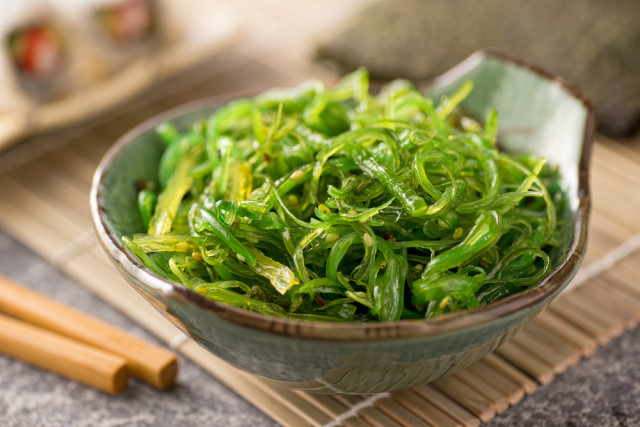Why We Should All Be Eating More Seaweed

Image: Foodio
How to Bring Seaweed Home to Your Kitchen
According to local whole foods expert Lauren Chandler of Lauren Chandler Cooks, sea vegetables are high in iodine, calcium, iron, manganese, zinc, phosphorus, and potassium, plus they contain vitamins A, B complex, and C. They're basically a whole-food multi-vitamin! Here, Chandler shares a few easy ways to incorporate sea vegetables into your DIY meals:
- You can toss wakame (sea lettuce) into miso soup towards the end of cooking time—just soak and eat it. Simple.
- Nori—the familiar wrapping for sushi rolls—is easy to tear up and add to a salad or even stir into oatmeal for soothing, savory comfort.
- Make homemade jellies with agar agar, a clear sea veg substitute for gelatin.
- Cook beans with kombu, because the minerals in the seaweed absorbs into the beans while they cook making them flavorful and potentially easier to digest. You can also chop the kombu up fine once it's soft and stir it back in with the beans for extra flavor.
- Check out Restaurant Beck chef Justin Wills's recipe for albacore crudo and sea beans, which you can harvest yourself on the Oregon coast.
Wondering where to buy high-quality sea greens? Local forager and botanist Ryan Drum leads seaweed gathering workshops and offers sustainably sourced bulk kelp and bladderwrack in addition to wild foods like wild carrot seeds, cedar tips, nettles, Oregon grape root, yarrow, and willow bark. Chandler also recommends checking out seaveg.com and theseaweedman.com.
Where to Indulge in Seaweed Dishes in PDX
Nutritionists aren't the only ones digging seaweed right now—plenty of local chefs are taking sea veggies out of the sushi bar and into some unexpected places.
Stray Dogs: Peter Cho and Johnny Leach, the cheffy pair of New York transplants behind Portland's artisan hot dog pop-up dinners, recently spiked classic potato salad with seaweed of a savory punch.
Prasad/Harlow: The vegan and gluten-free Dragon Bowl and Urban Bowl at chic and healthy Pearl District café Prasad and SE Hawthorne sister restaurant Harlow pair sea vegetables with avocado, steamed greens, sesame seeds, hemp seeds, kimchi, or chipotle black bean chili.
Smallwares: NE Fremont's asian-mashup specialists are serving a tasty spring salad: a toss of Calabrian chilies, nori, and breadcrumbs topped with tofu ranch. Also look for asparagus topped with gochujang, fried eggs, hijiki, and pine nuts.
Mojo Crepes: This SE Division café serves Japanese-street-vendor-style dessert crepes in addition to all-beef "Japanese Hot Dogs" loaded with seaweed and other toppings, from pickled daikons and teriyaki sauce to wasabi mayo and kimchi.
Boke Bowl: The Portland-style ramen pushers offer a perfect snack while you're waiting for your big bowl of broth and noodles—a pickle plate loaded with house-pickled vegetables, ginger-green onion rice, and Korean seaweed.
Snap up some Sea Greens for snacking
They may not be local, but we're downright obsessed with paleo-friendly, non-GMO Project-verified SeaSnax seaweed chips from Los Angeles and their new line of naturally flavored nori wraps and protein-packed, low-calorie Chomperz that meld rice flour with seaweed, tapioca, and flavors like onion, barbecue, and jalapeno. Find them at Whole Foods and New Seasons markets.
*Chandler notes that folks with sensitivity to iodine should talk to their doctor before upping their seaweed intake!
